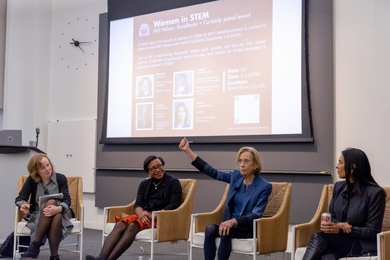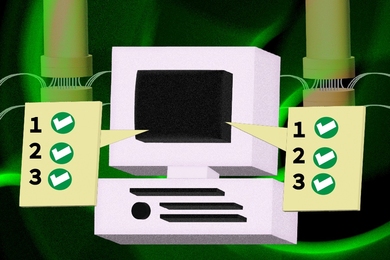In "Contact MIT," a presentation that followed last Thursday's freshmen convocation, Dean Kip Hodges quickly disabused the freshmen of any incorrect myths about MIT culture that they may have picked up from the movies.
As he took the stage wearing a winter scarf around his neck in a mocking tribute to the neckwear worn by the Good Will Hunting math professor, Dr. Hodges, a professor of geology and the dean for undergraduate curriculum, said, "I wanted to show you at least one MIT professor wearing a scarf."
Professor Hodges presented several campus scenes from the Academy Award-winning movie that tells the story of a young MIT janitor who is actually a brilliant mathematician with a bad attitude. Professor Hodges contrasted those scenes with video of the real MIT campus made especially for that purpose.
In one Good Will Hunting scene, the math professor, a Fields Medalist, walks into a grungy Building Services furnace room to get the name of what he assumes to be a brilliant, classroom-cleaning student. In the movie, the two surly, scruffy-looking maintenance men display complete disrespect for the professor and his tagalong graduate student by introducing themselves as professors and initially refusing to cooperate.
Professor Hodges then ran his own video clip of the same hunt.
The clip shows Professor Hodges entering a clean, tidy Physical Plant office and approaching the young woman behind the desk to see if she can identify a certain employee. When a description of the young man doesn't ring a bell with the woman, Professor Hodges shows her a photo of Matt Damon (who played the brilliant janitor in the movie) and asks if he looks familiar.
Susan Scoppettuolo shook her head and said, "If a guy that looked like this worked here, I'd remember." After a short pause she asked, "Hey isn't this that Caprio guy?"
The next scene from the movie showed Mr. Damon's character receiving one-on-one tutoring at a blackboard in the math professor's office, described by Professor Hodges as "a Victorian sitting room." This was followed by a slice of reality: the incredibly cluttered office of Professor Daniel Kleitman, a real-life MIT math professor who has stacks of papers covering his shelves and floor.
Professor Hodges closed the presentation on a more serious note by telling the freshmen about the old "Rad Lab" and Vannevar Bush's impact on the nation's science and technology policy. Echoing Professor Bush's belief that great scientists and engineers can be "versatile and yet not superficial," he advised students not to concentrate all their efforts on a narrow field of study.
"Learn to think critically," he said. "If anybody's here who just wants to pad their GPA or get vocational training, look around you -- the exits are clearly marked."
'BEER, BOOZE AND BOOKS'
Part-way through alcohol counselor Jim Matthews's presentation at Kresge Auditorium on Saturday morning, he asked members of the audience to rise if they knew someone who had been killed in an alcohol-related automobile accident.
About 400 MIT students -- half the audience -- stood up.
It was a dramatic way to show the deadly price society pays for the careless use of alcohol.
Mr. Matthews's multimedia program, entitled "Beer, Booze and Books," was sponsored by the Interfraternity Council as part of Orientation Week. Mr. Matthews is a special assistant to the vice president for alcohol and other drug programs at Keene State College in New Hampshire.
He used examples from advertising, TV and movies -- including John Belushi in Animal House, the Budweiser frogs and Beauty and the Beast -- to show how young people are conditioned to accept alcohol use as a normal part of life from an early age. He also used scientific data to show how alcohol affects physical and mental capabilities. "H-A-L-T," he said. "If you're hungry, angry, lonely or tired, you probably shouldn't drink."
The program was sprinkled with taped interviews of MIT students discussing their attitudes and experiences with alcohol.
Mr. Matthews concluded by reciting a mnemonic that reminds the students to "GET REAL" -- goals, education, tradition, responsibility, enthusiasm, activities and "love thy neighbors as you do yourself."
After the 75-minute session, the students divided into small groups to discuss the issues raised among themselves and with orientation leaders.
THE FIRST SUPPER
A new welcoming dinner was the first social activity for all freshmen on Wednesday evening. Held in Johnson Athletics Center, the 1,053 men and women were entertained by Professor Paul Lagace of aeronautics and astronautics (who admitted he got a 27 on a test his freshman year) and Professor Emeritus Jay Keyser of linguistics and philosophy, who presented a slide show on MIT's famous hacks.
It was a time for students to get to know one another, and to ask questions of the student orientation leaders or members of faculty or staff who helped host the event. "How much sleep do you get?" asked one young woman, looking worried. "About six hours," said the leader. "Oh, that's not too bad," she said.
The advice of the 21-year-old sophomore at one table sounded a lot more convincing, but very similar to what the students might have heard from a parent or faculty member three times their age.
"Pay attention to Pass/Fail," he said. "It won't be recorded if you fail, but when you go for a summer job and they see you only have two courses down for first semester, they know that means you failed the others." The student admitted to failing grades in his first semester "because I wanted to do everything" but said he settled down second semester and got at least one A.
"Attend the lectures, and stay awake!" he counseled. At one lecture, he said the professor outlined what was going to be on a test. A good friend of the student's skipped the lecture, didn't have a clue, and failed.
After dinner, most of the class went over to the Student Center for activities ranging from dessert to caricature drawings to movies.
ADVICE TO THE LOVELORN
Professor Nancy Hopkins told freshmen she had just one wish for them: that they fall in love.
"Not with that extremely interesting person who may be sitting a few rows in front of you," said Professor Hopkins, welcoming the Class of 2002 on behalf of the Institute's 738 faculty members during the freshmen convocation on Thursday, "but with an intellectual vision of the future that you may not have imagined yet.
"It happened to me when I was an undergrad -- not at MIT, but at an institution up the river called Harvard" -- which drew a loud hiss from the audience. "I went there thinking I would be a math major��������������������������� But one day I went to a class where a lecture was about to be delivered by Professor James D. Watson. At the end of that hour I was not a math major. I was in love -- with DNA."
She described the sorts of questions that motivate her research in developmental biology: "How do you make a hand? Why do I look like my mother? The possibility that you can answer questions like these is intoxicating, passion-inducing. When you hit the right topic for you, it becomes addictive."
She then showed a time-lapsed video of a fertilized zebra fish egg dividing every 20 minutes. "About 18 hours after you start, you have something recognizable as a little fish," she said. After just five days, the creature's development is remarkably complete. "What did you accomplish in the last five days?" she asked the freshmen.
"I expect some of you will figure out how to grow human organs during your careers as molecular biologists. I hope you will do so using genes related to those we hope to find in the fish in the next few years," she said.
"I was lucky to be born to a generation of biologists who discovered the molecular basis of life. You were lucky to be born to a generation of biologists that will discover the molecular basis of most human diseases and gain control over them. You may even be able to modify and design life.
"What gets me up in the morning to clean those 4,592 fish tanks in my lab? The passion to know the answers. It's like falling in love -- mysterious, uniquely human and utterly wonderful."
VIOLENCE PREVENTION
The question made little sense to the 50-60 men in Kresge Auditorium: "What do you do daily to prevent yourself from being sexually assaulted?"
The answer: nothing.
But the 15 or so women revealed a series of strategies, from holding keys a certain way in case they are needed as a weapon, to traveling in groups, dressing modestly and so forth.
This framed the issues at the Mentors in Violence Prevention program at Kresge Auditorium on Friday night, moderated by Jeff O'Brien of Northeastern University's Center for the Study of Sport in Society.
Mr. O'Brien, a Division 1AA All-American tight end at Canisius College, pointed out that one in four college women was a victim of rape or attempted rape during the previous year. He said women were at highest risk during their first semester. He noted the subtle ways in which society supports a "rape culture." For example, he said, sexist jokes, while not a direct cause of violence, contribute to an acceptance of disrespect for women. He challenged students to think about how they react when they hear demeaning words or attitudes expressed against women, and told them their reactions can make a difference.
END OF SCIENCE?
Science definitely has a future, concluded most speakers at a symposium at Kresge Auditorium on Thursday that focused on the theme of The End of Science, a 1996 book by John Horgan.
Mr. Horgan himself, one of the speakers, said that there are "enormous opportunities" in mind-related research. Neuroscience, for example, has shown that different regions of the brain are specialized for carrying out different functions, "but [the discipline] can't tell us how we think." There is also no "neuroscience of personality."
Three student winners of last year's essay contest on The End of Science offered their perspectives. Amy K. Strickert, a sophomore in electrical engineering and computer science, offered three "diagnostic questions" to think about when considering the health of science. "What questions remain unanswered, and will we think of new questions in the future? Will there be enough funding to support basic research in the future? Will there be an adequate supply of new scientists and engineers in the future?"
The answers, she said, "made me conclude that we are not near the end of science."
The environmental and social impacts of science and engineering were the focus of Anna M. Dirks's comments. The senior in electrical engineering and creative writing said, "I believe there is a serious problem with the way we [teach] science in the US and especially at MIT." Scientists and engineers "operate as though science is an end in itself." Her parting words: "Please don't graduate without understanding the social and environmental implications of your work."
David Hamby, a senior in architecture, commented on "the difficulty of getting past the [scientific] frontier because we have to synthesize what we already know, and that's lots of stuff." He stressed the value of visual aids to learning, which he believes are key to teaching science.
A version of this article appeared in MIT Tech Talk on September 2, 1998.





